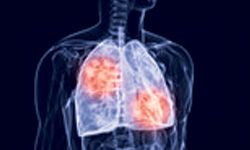Vemurafenib Active as Monotherapy in BRAF V600 NSCLC
Vemurafenib monotherapy is an effective treatment for patients with BRAF V600-mutated non–small cell lung cancer, according to results from the phase II AcSe vemurafenib trial II study published in the Annals of Oncology.

Vemurafenib (Zelboraf) monotherapy is an effective treatment for patients withBRAFV600-mutated nonsmall cell lung cancer (NSCLC), according to results from the phase II AcSé vemurafenib trial published in the Annals of Oncology. The study also recommends that screening for theBRAFV600 mutation should be a part of routine genomic testing for patients with NSCLC.
BRAFV600 mutations were found in 96% of the 194 patients enrolled (n = 97). The BRAFV600 mutations observed included V600E (n = 97), V600K (n = 2), V600D (n = 1), and V600M (n = 1). Patients with non-BRAFV600 mutation represented 4% of the enrolled patient population. The non-BRAFV600 mutations observed included G469A (n = 3) G466V (n = 3), N581S (n = 3), K601E (n = 3), K601N (n = 2), G466A (n = 1), G469V (n = 1), and G596R (n = 1).
In total, 115 of the 194 patients enrolled were treated with vemurafenib. Treatment lasted for a median duration of 3.3 months (range 0.03-27.4) in patients with V600 mutation and 1.5 months (range 0.2-2.1) in patients with non-V600 mutations. Sixty percent of patients with V600 mutations required dose modifications due to toxicity as did 12% of patients with non-V600 mutations. Discontinuation of vemurafenib treatment occurred in 56% of patientsBRAFV600 NSCLC due to disease progression and 24% due to toxicity. In the non-BRAFV600 cohort, 67% of patients discontinued vemurafenib treatment due to disease progression and 20% discontinued due to toxicity. Additionally, there were 4 discontinuations in the BRAF V600 cohort prior to the tumor assessment, which were not included in the efficacy analysis.
After a median follow-up of 23.9 months (95% CI, 19.8-25.0), the mean Bayesian estimated success rate was 44.9%, with a confidence interval between 35.2% and 54.8%. A 99.9% probability that the overall response rate would be above the efficacy of 30% was hypothesized.
The median duration of response observed was 6.4 months (95% CI, 5.1-7.3). The investigators also observed a median progression-free survival of 5.2 months (95% CI 3.8-6.8) and a median overall survival of 10 months (95% CI 6.8-15.7).
An analysis of theBRAFV600 cohort versus the non-BRAF V600 cohort showed that vemurafenib is not active in non-BRAFV600 NSCLC. The median PFS observed in the BRAFV600 cohort, however, was 3.8 months in patients with V600-D, 5.9 months for V600-M, and 2.1 and 6.8 months for the 2 patients with V600-K NSCLC.
In a subgroup of patients with brain metastasis (n = 26), the median PFS was 1.9 months (95% CI 1.5-3.9). For those without brain metastasis (n = 89), the median PFS was 5.4 months (95% CI, 3.8-7.2).
Vemurafenib demonstrated a similar safety profile to what has been previously reported. The most treatment-related adverse events (TRAEs) in theBRAFV600 cohort were asthenia (56%), decreased appetite (46%), acneiform dermatitis (37%), and nausea/diarrhea (35%). The most common grade 3 or higher TRAEs were asthenia (10%), cutaneous epidermoid carcinoma (8%), dermatitis (6%), and increased gamma-glutamyl transpeptidase levels (6%).
The most frequent grade 3 or higher TRAEs among patients with non-BRAFV600 mutations were asthenia (27%), general physical health deterioration (13%), and pruritus ( 13%). Additionally, 3 patients died as a result of grade 5 toxicities (dehydration, pneumonia, and neutropenic sepsis). The toxicities that led to treatment discontinuation included cutaneous toxicity (n = 8), infections (n = 5), and hepatitis (n = 4). Serious AEs were observed in 36% of the BRAFV600 cohort and 27% of the non-BRAFV600 cohort.
The participants of the basket phase II, open-label AcSé vemurafenib trial were predominantly male (51%) at a median age of 65.8 years and most were smokers (68%). Of the patients who were smokers, 59% were in theBRAFV600 cohort and 86% were in the non-BRAFV600 cohort. Patients in the study were given oral vemurafenib 960 mg twice daily until disease progression, unacceptable toxicity, or at the patient’s choice.
The primary end point of the study was the confirmed ORR, with the tumor response measured every 8 weeks from baseline by CT scan using RECIST v1.1. The secondary end points included duration of response, progression-free survival (PFS), and overall survival (OS).
The study included patients with histologically confirmed advancedBRAF-mutant NSCLC, measurable lesion, and ECOG performance status 2 or lower. Some individuals were excluded from the study based on prior treatment, infection, and comorbidity.
As an explanation of the study results, Mazieres et al wrote “Our results are the first to show that vemurafenib is not effective in [patients with] NSCLC withBRAFnonV600-mutated tumors. The reason for this lack of activity is unknown. Perhaps these mutations play only a minor role in oncogenesis, or perhaps, vemurafenib has a limited inhibitory effect with these mutations. Preclinical data suggest that the NSCLC tumors of someBRAFnonV600 mutants may be sensitive to dabrafenib combined with trametinib, but less sensitive with dabrafenib alone.”
Reference:
Mazieres J, Cropet C, and Montane L, et al. Vemurafenib in non-small-cell lung cancer patients with BRAF V600 and BRAF nonV600 mutations.Annals of Oncol. 2020; 2;289-294. DOI: 10.1016/j.annonc.2019.10.022.
Selection of First-Line NSCLC Therapy Influenced by Delayed Testing
March 8th 2024During a Targeted Oncology™ Case-Based Roundtable™ event, Misako Nagasaka, MD, PhD, asked participants how they would approach therapy for a patient with metastatic non–small cell lung cancer when biomarker testing is not yet completed. This is the second of 2 articles based on this event.
Read More
Comprehensive Molecular Testing Needed for Frontline NSCLC Treatment
February 19th 2024During a Targeted Oncology™ Case-Based Roundtable™ event, Misako Nagasaka, MD, PhD, held a discussion on the use of biomarker testing in patients with advanced non–small cell lung cancer. This is the first of 2 articles based on this event.
Read More